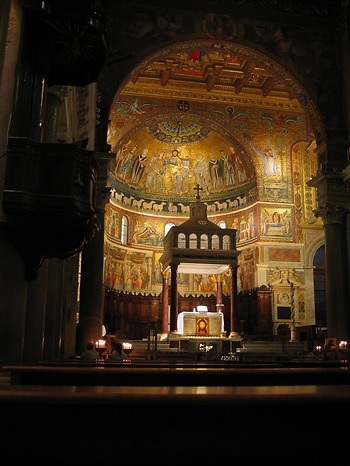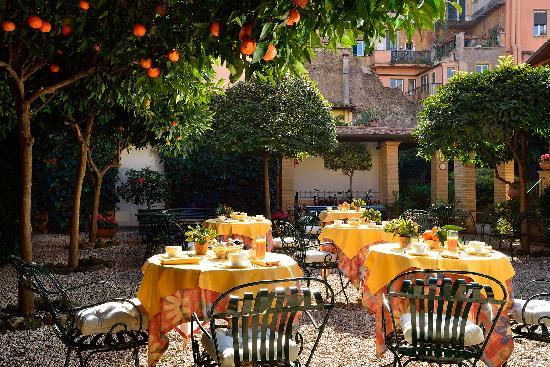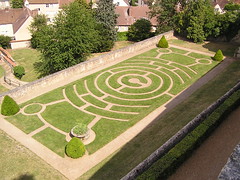
On The Marcella Hazan Trail: Paschal Lamb or Abbacchio alla Cacciatora
Publication of Marcella’s last book, Ingredienti, on July 12, 2016, translated and edited by Victor Hazan
At Easter Rome is bursting with pilgrims. They gather from across the Catholic globe and descend on the Eternal City like flocks of birds returning from their wintering grounds. Nuns cluster like crows, standing in line for the wonderful gelato, then swish down the narrow streets, rosaries jostling against coni.
I too visited Rome at Easter on a pilgrimage and, while my quest was corporeal, it was no less spiritual, for I had come in search of the Paschal Lamb. I wanted to cook Abbacchio alla Cacciatora. This dish of early spring lamb can only be prepared during a few short weeks as the lamb required is but one month old. The Italian sheep are a smaller breed to those farmed in the UK and, consequently, the lambs are smaller too. At their tender age, the lambs have only drunk milk. The thigh bone is no longer than that of a chicken drumstick. The meat is tender beyond description.
I discovered this dish while searching for recipes to prepare on a family holiday in Rome — as the old adage suggests, “when in Rome do as the Romans do.” My chosen recipe was from Marcella Hazan’s The Classic Italian Cookbook, a treasure trove of Italian cuisine. She describes the dish as a celebrated Rome speciality, which suggested to me that to cook it in Rome was imperative.

On the morning of our anticipated feast, my family set out early for the Campo de’ Fiori where I expected to find the full list of my ingredients, as the market stalls and small shops surrounding the square sell every culinary delight one could need for a happy life. On arriving at the Campo, my young sons were immediately intent on securing football shirts before my attention was diverted. For the princely sum of 10 Euros apiece, they each walked off in a “fake” footie shirt bearing the name of Totti, Roma’s favourite son. Their attire had a magical effect as they were soon patted on the head and smiled at by every man we passed, from the local stall owner to the guards in the Vatican! The universal language of football and the passion it evokes is at least equal to the glories of cuisine amongst Italian men. Perhaps the food served up at the Stada di Roma is an improvement on the hotdog and chips ubiquitously sold to English football fans attending a game on home turf.
But what of the lamb? The Campo hosted a butchery stall where I explained my mission. The butcher set about chopping up the meat of tiny carcasses, not a sight for the squeamish or sentimental nor for vegetarians or the virtuous. The meat was delicately wrapped in greaseproof paper and settled in my shopping bag. I set off for the Salumeria in search of salted anchovies. The Italian delicatessen was an Aladdin’s cave filled with oils, vinegars and relishes of every kind. Huge hams formed a sculptural installation on the ceiling. Tiny tins contained exotic ingredients. There was an array of pancetta, prosciutto and other meats, fresh pasta of every hue and flavour, pesto and parmesan wheels, an endless store of delights to bring a rush of excitement to the most jaded palate.

The customers discussed their requirements with the shop assistants who acknowledged the importance of every purchase and handled the food courteously, each item wrapped with care. My request for salted anchovies led to a debate between two assistants as to which anchovy would be better suited to Abbacchio. A third joined in and asked to see my recipe which I had removed from my bag to check on whether any guidance was offered by Ms. Hazan herself. He shook his head gravely and announced to my fellow customers that he had never prepared Abbacchio in this way and that, in his opinion, the anchovies had no place in the dish. I decided to have the casting vote and soon 10 anchovies were laid out. My shopping trip gave slow food a new meaning. Every ingredient was deliberated over, the assistants presented as specialists in their field who contribute their knowledge to enhance the food that will end up later on your plate.

Although described as a dish that is slowly pot roasted, the cooking time was surprisingly short due to the tenderness of the meat. The lamb was browned in batches. Then salt, pepper, chopped garlic, rosemary and dried sage were added before the meat was dusted with flour. Once the meat had been turned and it had darkened, the vinegar was added. The recipe does not specify what sort of vinegar to use but I think that balsamic adds great value to meat and so in went more vinegar than seemed sensible. The aroma that filled the kitchen at that moment was exquisite and the gathering guests were drawn to the tiny galley to discover the source. The anchovies were mashed and added at the end of cooking, giving the sauce a salty punch.
Within an hour we sat to eat on a terrace up above the city, the weather warm enough, even on an April evening, for al fresco dining. The Chianti flowed and the conversation was convivial but it was the lamb that stole the show. Meltingly tender, the meat was basted in its sauce which married the sweet balsamic and salty anchovies with the garlicky back note of herbs. A simple accompaniment of fave alla romana was served. It is true that food is best enjoyed when much anticipated and I had been waiting all day. It was declared by many as the best lamb they had ever eaten and who am I to disagree? Even the football shirts proudly bore the stains of a meal well savoured.
The Abbacchio grows ever more delicious in my memory as the years go by, tormenting me with the knowledge that I cannot recreate it in my own kitchen. Perhaps I too will have to make an annual Easter pilgrimage to Rome. As for the football shirts, they unravelled on their first wash and Totti will someday be sold to a rival team. In a world where everything is transient and football heroes are fickle, my sons are learning that when it comes to food, some things don’t change and old traditions can always be relied on to provide enduring pleasure
__________________________
Madeleine Morrow is a freelance food and travel writer based in London and writes for several newspapers based in the U.S. and in South Africa. She also has two blogs. Kitchen Journeys (www.kitchenjourneys.net) has a focus on travelling with family in search of culinary adventure. It also covers restaurants reviews in London. From The Healthy Heart (www.fromthehealthyheart.com) has a focus on lowering cholesterol through eating delicious food.
***
From the publisher Simon and Schuster’s website:
When Marcella Hazan died in 2013, the world mourned the passing of the “Godmother of Italian cooking.” But her legacy lives on, through her cookbooks and recipes, and in the handwritten notebooks filled with her thoughts on how to select the best ingredients—Ingredienti, coming out on July 12. Her husband and longtime collaborator Victor Hazan has translated and transcribed these vignettes on how to buy and what to do with the fresh produce used in Italian cooking, the elements of an essential pantry, and salumi, resulting in this new book.
Before you know how to cook, you must know how to shop. From Artichokes to Zucchini, Anchovies to Ziti, Ingredienti offers succinct and compelling advice on how to choose vegetables, pasta, olive oil, Parmigiano Reggiano, prosciutto, and all of the key elements of Marcella’s classic meals. Organic isn’t necessarily best, boxed pasta can be better than fresh. Marcella’s authoritative wisdom and surprising tips will change the way you cook. Her clear, practical guidance in acquiring the components of good cooking is helpful wherever you choose to shop—in supermarkets, farmers’ markets, specialty food stores, or online.
Based on sixty years of almost daily visits to the market to choose the ingredients of that day’s meal, Ingredienti is a life’s work, distilled—an expression of Marcella’s judgments, advice, and suggestions. Uncomplicated and precise, this volume will be essential to home cooks eager to produce meals in the same delicious style Marcella was the first to introduce to America.
|
|








































